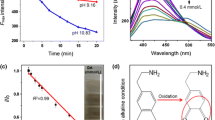Abstract
In this article, a novel chemiluminescence method using water-soluble CdS quantum dots (QDs) as sensitizers is proposed for the chemiluminometric determination of epinephrine. The method is based on the quenching effect of epinephrine on the chemiluminescence emission generated by the mixing of CdS quantum dots (QDs) with hydrogen carbonate (HCO3 -) in the presence of hydrogen peroxide (H2O2) in an alkaline medium. The optimization of variables influencing the chemiluminescence response of the method has been carried out by using experimental design. Under the optimal conditions, there is good linear relationship between the relative chemiluminescence intensity and the concentration of epinephrine over the range of 5 × 10−9–1 × 10−6 molL−1 with a 3σ detection limit of 5 × 10−11 molL−1. The method has been successfully applied to the determination of epinephrine in pharmaceutical formulation and the recovery test was done in human urine.





Similar content being viewed by others
References
Tive L (2000) Celecoxib clinical profile. Rheumatology 39:21–28
Koki AT, Leahy KM, Masferrer JL (1999) Potential utility of COX-2 inhibitors in chemoprevention and chemotherapy. Exp Opin Investig Drugs 8:1623–1638
Sherry Chow H-H, Anavy N, Salazar D, Frank DH, Alberts DS (2004) Determination of celecoxib in human plasma using solid-phase extraction and high-performance liquid chromatography. J Pharm Biomed Anal 34:167–174
Paulso SK, Kaprak TA, Gresk CJ, Fast DM, Baratta MT, Burton EG, Breau AP, Karim A (1999) Plasma protein binding of celecoxib in mice, rat, rabbit, dog and human. Biopharm Drug Dispos 20:293–299
Strömer E, Bauer S, Kirchheiner J, Brockmöller J, Roots I (2003) Simultaneous determination of celecoxib, hydroxycelecoxib, and carboxycelecoxib in human plasma using gradient reversed-phase liquid chromatography with ultraviolet absorbance detection. J Chromatogr B 783:207–212
Su Y, Wang J, Chen G (2005) Determination of epinephrine based on its enhancement for electrochemiluminescence of lucigenin. Talanta 65:531–536
Guirguis MS, Sattari S, Jamali F (2001) Pharmacokinetics of celecoxib in the presence and absence of interferon-induced acute inflammation in the rat: application of a novel HPLC assay. J Pharm Pharm Sci 4:1–6
Guo Y, Yang J, Wu X, Du A (2005) A sensitive fluorimetric method for the determination of epinephrine. J Fluoresc 15:131–136
Guo Y, Yang J, Wu X, Mao H (2007) Study on the co-luminescence effect of Tb–Gd–epinephrine system and its application to the sensitive determination of epinephrine at nanomol level. Talanta 73:227–231
Kawamori T, Rao CV, Seibert K, Reddy BS (1998) Chemopreventive activity of celecoxib, a specific cyclooxygenase-2 inhibitor, against colon carcinogenesis. Cancer Res 58:409–412
Babaei A, Mirzakhani S, Khalilzadeh B (2009) A sensitive simultaneous determination of epinephrine and tyrosine using an iron(III) doped zeolite-modified carbon paste electrode. J Braz Chem Soc 20:1862–1869
Harris RE, Alshafie GA, Asbou-Issa H, Seibert K (2000) Chemoprevention of breast cancer in rats by celecoxib, a cyclooxygenase 2 inhibitor. Cancer Res 60:2101–2103
Medintz IL, Uyeda HT, Goldman ER, Mattoussi H (2005) Quantum dot bioconjugates for imaging, labeling and sensing. Nat Mater 4:435–446
Parak WJ, Pellegrino T, Plank C (2005) Labeling of cells with quantum dots. Nanotechnology 16:R9–R25
Wang X, Ruedas-Rama MJ, Hall EAH (2007) The emerging use of quantum dots in analysis. Anal Lett 40:1497–1520
Gao M, Kirstien S, Mohawald H, Rogach AL, Kornowski A, Eychmuller A, Weller H (1998) Strongly photoluminescent CdTe nanocrystals by proper surface modification. J Phys Chem B 102:8360–8363
Chen H, Li R, Lin L, Guo G, Lin J-M (2010) Determination of l-ascorbic acid in human serum by chemiluminescence based on hydrogen peroxide–sodium hydrogen carbonate–CdSe/CdS quantum dots system. Talanta 81:1688–1696
Huang C-P, Li Y-K, Chen T-M (2007) A highly sensitive system for urea detection by using CdSe/ZnS core-shell quantum dots. Biosens Bioelectron 22:1835–1838
Liu M, Xu L, Cheng W, Zeng Y, Yan Z (2008) Surface-modified CdS quantum dots as luminescent probes for sulfadiazine determination. Spectrochim Acta A 70:1198–1202
Callan JF, Mulrooney RC, Kamila S, McCaughan B (2008) Anion sensing with luminescent quantum dots—a modular approach based on the photoinduced electron transfer (PET) mechanism. J Fluoresc 18:527–532
Wang ZP, Li J, Liu B, Li JH (2009) CdTe nanocrystals sensitized chemiluminescence and the analytical application. Talanta 77:1050–1056
Sun C, Liu B, Li J (2008) Sensitized chemiluminescence of CdTe quantum-dots on Ce(IV)-sulfite and its analytical applications. Talanta 75:447–454
Montgomery DC (1997) Design and analysis of experiments, 4th edn. Wiley, New York
Chen HM, Huang XF, Xu L, Xu J, Chen KJ, Feng D (2000) Self-assembly and photoluminescence of CdS-mercaptoacetic clusters with internal structures. Superlattice Microst 27:1–5
Wang Z, Li J, Cheong S, Bhaskar U, Akihiro O, Zhang F, Dordick JS, Linhardt RJ (2011) Response surface optimization of the heparosan N-deacetylation in producing bioengineered heparin. J Biotechnol 156:188–196
Box GEP, Behnken DW (1960) Some new three level designs for the study of quantitative variables. Technometrics 2:455–475
Adinarayana K, Ellaiah P (2002) Response surface optimization of the critical medium components for the production of alkaline protease by a newly isolated Bacillus sp. J Pharm Pharm Sci 5:272–278
Yu WW, Qu L, Guo W, Peng X (2003) Experimental determination of the extinction coefficient of CdTe, CdSe, and CdS nanocrystals. Chem Mater 15:2854–2860
Yao HR, Richardson DE (2003) Bicarbonate surfoxidants: micellar oxidations of aryl sulfides with bicarbonate-activated hydrogen peroxide. J Am Chem Soc 125:6211–6221
Richardson DE, Yao HR, Frank KM, Bennett DA (2000) Equilibria, kinetics, and mechanism in the bicarbonate activation of hydrogen peroxide: oxidation of sulfides by peroxymonocarbonate. J Am Chem Soc 122:1729–1739
Liu M, Zhao L, Lin J-M (2006) Chemiluminescence energy transfer reaction for the on-line preparation of peroxymonocarbonate and Eu(II)−dipicolinate complex. J Phys Chem A 110:7509–7514
Liu X, Jiang H, Lei J, Ju H (2007) Anodic electrochemiluminescence of CdTe quantum dots and its energy transfer for detection of catechol derivatives. Anal Chem 79:8055–8060
Author information
Authors and Affiliations
Corresponding author
Rights and permissions
About this article
Cite this article
Azizi, S.N., Chaichi, M.J., Shakeri, P. et al. Determination of Epinephrine in Pharmaceutical Formulation by an Optimized Novel Luminescence Method Using CdS Quantum Dots as Sensitizer. J Fluoresc 23, 227–235 (2013). https://doi.org/10.1007/s10895-012-1138-x
Received:
Accepted:
Published:
Issue Date:
DOI: https://doi.org/10.1007/s10895-012-1138-x




